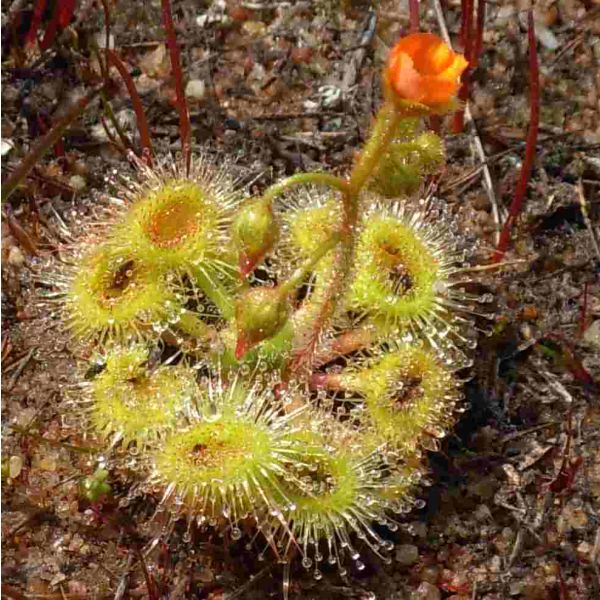Drosera Glanduligera Seeds (Australian)
Drosera Glanduligera Seeds (Australian)
Flowers late Winter to late Spring, which are orange to red in colour. This species produces an extremely large number of seeds.

Delivery
All orders shipped with UPS Express.
Always free shipping for orders over US $250.
All orders are shipped with a UPS tracking number.
Returns
Items returned within 14 days of their original shipment date in same as new condition will be eligible for a full refund or store credit.
Refunds will be charged back to the original form of payment used for purchase.
Customer is responsible for shipping charges when making returns and shipping/handling fees of original purchase is non-refundable.
All sale items are final purchases.
Help
Give us a shout if you have any other questions and/or concerns.
Email: contact@domain.com
Phone: +1 (23) 456 789
Availability: Out of stock
SKU
Drosera Glanduligera
Drosera glanduligera is a subtropical found in South Western and South Eastern Australia and Tasmania. It can be quite abundant in certain locations.
It produces tiny, flat and hairy golden-green rosettes up to 3 cm in diameter. In August to October, multiple short, only 12 cm tall, glandular scapes are produced. Flowers late Winter to late Spring, which are orange to red in colour. This species produces an extremely large number of seeds.
The leaves of this plant are covered with glandular hairs like any other sundews. The leaves are short and spoon-shaped. The visiting insects are attracted to the leaves by the glistening tips of the hairs. Once caught the insect is digested by the sticky digestive fluid poured out by the plant. This unique way of obtaining nitrogenous food enables these plants to live in soils poor in available nitrogen.
The plant has normally a short life. You can maintain Drosera glanduligera a number of years if you remove the flower stalks before the flowers open. If you allow them to bloom even once, the plants will be reduced in size substantially and may have difficulty recovering. From seed to a flowering plant you don't have to wait a year. If you cut off the flower-stalk it is possible to have the plant for 2-3 years.
Drosera glanduligera is a Winter growing annual. This species germinate, grow and flower in the rainy season, Fall and Winter. Drosera glanduligera does not go dormant in the wild, but sometimes slows down in the hot and dry Summer of Australia. Can live for years if you remove flower stalks as soon as they appear, and keep watering.
Hardiness zone 10, (4øC/40øF) in Winter. Must be grown in the shade, and must be protected from direct sun. Temperatures should be kept below 22øC / 71øF by days, and nights around 10øC /50øF. It apreciates cold nights, but avoid frosts at all costs. This usually corresponds to typical Fall weather in temperate and Mediterranean climates. If your weather gets cool then hot again in the Fall, any young plants will need to be protected from warm temperatures. Grows in diverse soil conditions, but will do better in a soil consisting of two part sand for one part peat moss.
Requires consistently moist soil, do not let dry out between waterings. Water must be distilled or rain water because they do not tolerate city or hard water. It is a good idea to place a pie pan or large saucer, with about an inch of water in it, under the pot. Elevate the pot by placing pebbles under it so that the base of the pot is barely in contact with the water, not submerged; the growing medium must stay moist, but never soggy. This will keep the humidity around the plant higher and it will ensure that the plant has a constant source of moisture. The humidity should be between 60-80%.
| Label | Drosera glanduligera |
|---|---|
| Common name | Pimpernel Sundew |
| Genus | Drosera |
| Species | Drosera glanduligera |
| Germination | The seeds require 6 weeks hot stratification. Sow directly on the surface of your moist but not soaked soil mix. Do not cover them with any medium, the seeds are really tiny. After hot stratification, somewhat uncover the top of the pot, so that moisture and heat drop a little. Place the pot in an area with real nice strong light and keep the temperature around 20øC/68øF. When you see some tiny plants starting to sprout, slowly open the top of the pot, a little each day, so that the new seedlings don't go into shock from the humidity being lowered too quickly. After hot stratification, germination usually occurs in 1-3 months, but it can be prolonged up to several months, depending on their degree of unbroken dormancy, don't give up. Be very gentle with the new seedlings, not to destroy anything, it is very tiny. Make sure that it gets good air circulation. |
| Scarification / Stratification | It creates a hot and moist environment for the seeds. This will break their dormancy. Place the seeds on top of a prepared soil mix. Put the pots with seeds in plastic ziplock bags under but not too close to florescent lights. A temperature around 25øC / 76øF works best. Make sure to check the seeds often. If fungus or mold appears treat it with a fungicide. |
| Price View | Price Range |

